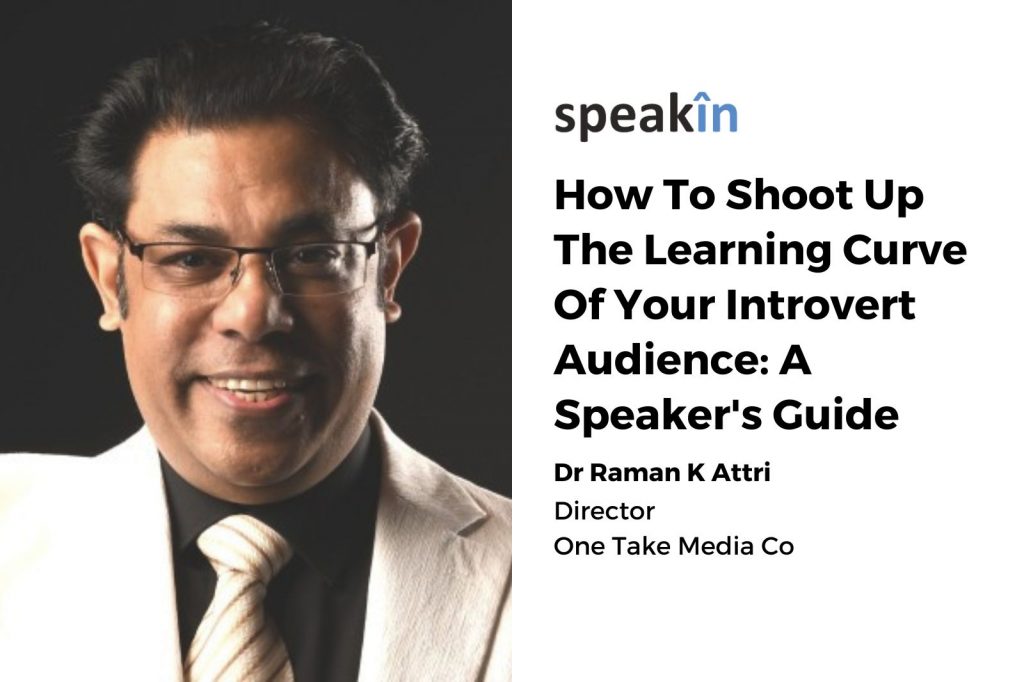How To Shoot Up The Learning Curve Of Your Introvert Audience: A Speaker’s Guide

MY INTROVERSION STORY
When I was a kid, I contracted polio. That took away my ability to walk and a large part of my mobility. I was devoid of any social network and lived in a highly impoverished and oppressed environment. I had no choice but to live with myself. Those environmental triggered me to grow up most of my childhood as an introvert.
I had an extreme inferiority complex that developed me into an introvert. I talked less and stayed within myself. I was not outgoing enough even to say hello to strangers.
The main thought in my childhood was how to learn faster so that I get noticed among predominantly extroverted classmates. As a general fact, the teachers back then usually used to pay more attention to active, highly vocal, extrovert students in the class.
Tied to a chair, with limited mobility and isolated in a room, I had no other weapon than to depend on my introvert tendencies. I needed to somehow figure out a way to use them to speed up my learning better than others.
In that zest, I probably read every single accelerated learning book available. However, none of those were written for introverted people. None of those guided how an introverted person should learn or leverage introverted preferences to learn better and faster.
I was gifted with a very analytical, critical, and experimental mind. So, I set on a path to do experiments on myself to find what could speed up my learning. It did not take me much longer to master that art and crack the code. I have earned over 100 international credentials and educational degrees in a very short period, including two doctorates.
How did I do this?
The answer is that I leveraged my significantly introverted tendencies.
I learned a fair deal about personality preferences through my explorations and research. I noticed that leveraging (or not leveraging) those personality preferences in a training program may positively (or negatively) impact the speed of learning of the corresponding group of learners. I observed how poorly the learning programs are designed, which do not cater evenly to both personality preferences. I investigated that there were some levers training designers and learning specialists could use in their programs to make learning effective for introverted learners.
THE INTROVERT LEARNING CHALLENGE
If you are a learning specialist or trainer, you might recall some seemingly shy, quiet, or backseat individuals in your training sessions. We have a label for such personalities. We call them introverts. While the challenge is prevailing elsewhere, it amplifies in leadership, management, or communication training in which trainers find it hard to train introverts. The fundamental issue is not that they don’t learn better. The real problem is that traditional methods designed for any training class are geared towards mostly extrovert personalities. The learners are required to present, converse, express, and demonstrate outwardly visible traits. When subjected to such ineffective training methods, some introvert learners resort to staying behind, and some do not receive enough support.
INTROVERT VS EXTROVERT PREFERENCES
I became a person with the largest friendship circle as I grew up. Today, I am now a professional speaker and have never come across as an introvert. In fact, I can seamlessly switch between these two labels depending upon where I am, what I am doing, whom I am interacting with, and the nature of the things I am doing.
As a performance scientist, I think introverts versus extroverts are situational preferences (or precisely the self-construed labels) that people tend to adopt for their most comfortable moments. The human mind does not respond to labels, but it may have particular preferences that develop over time. The way these behavioral patterns get ingrained in someone’s preferences has a lot to do with the environment, early childhood bringing, social interactions at a young age, and similar factors. These behavior patterns show some influence later in life, but these are not lines itched on the stones.
People do not deliberately choose to work or perform as extroverts or introverts. It seems like the human mind can adjust quickly and respond with the most appropriate behavior pattern (introvert or extrovert) in a situation, depending on the demand of the situation or task. An extrovert may want to get into an introvert shell once their energy diffuses. On the other hand, an introvert may adopt an extroversion outlook depending on the nature of the work. Also, it appears that one can switch between being introverted or extroverted depending on where they are, alone or with people, without losing the foundational personality.
How can you use this knowledge to design or conduct your training programs?
TIPS FOR DESIGNING YOUR TALK OR TRAINING
Based on the science of learning and the psychology of preferences, here are three tips for designing effective training exercises:
– Design training or talk for a multisensory experience
Irrespective of their psychological preferences, learners use all their senses to learn. The more senses are involved in learning, the better the learning will be. Thus, training material and assessment must be designed as multisensory experiences. Keep an appropriate mix of reading, listening, speaking, observing, and writing exercises in the training design. Put up the sequence and activities that invite learners to use as many senses as possible. When you do that, introverts would be equally effective in changing their preferences for the duration of the training, and they would contribute meaningfully.
– Balance vocal and written training exercises and assessments
At a basic level, introverts tend to observe, think, listen, read and write more. On the other hand, extroverts tend to speak, stand, walk, present, and explain more. Leverage those differences to assign exercises and assessments to introverts that foster more thinking, reflection, observations, and writing. When you use these levers, their learning is accelerated at a faster rate. Their final performance will be highly noticeable.
– Be flexible in how learners deliver their role plays or presentations
If your training program is more geared towards soft skills and requires learners to role-play or present, you can add flexibility to their design. Most introverts tend to use more whiteboards, slides, flip charts, and other teaching aids, while extroverts like people to focus on their faces and typically use fewer teaching aids. When designing individual presentation assignments, make sure your rubrics are not rigid and do not force specific teaching aids that could hinder their efficiency and comfort.
GETTING INTROVERTS (AND EXTROVERTS) THERE FASTER
Whether you are an introvert or an extrovert, learning faster matters the most in today’s world for all. You all need to be able to achieve desired or targeted outcomes for your job.
Where do you go to learn the strategies to learn faster and be a star leader in a much shorter time despite your introversion? I have cracked the code of speeding up the learning and performance curve by 200% to allow anyone, introvert or extrovert, to learn or achieve the same goals in half the time.
If you are a trainer or a learning and development professional, how do you do justice in your training to both groups of people and help them become star performers in as short a time as possible? I have produced several learning design frameworks that either eliminate the divide between introvert vs. extrovert learners or leverage that divides superbly to speed up the learning of everyone involved.
ABOUT THE AUTHOR
Dr Raman K Attri, named as one of the Brainz Global 500 leaders, alongside stellar leaders like Oprah Winfrey and Gary Vee, is a performance scientist and a world authority on speed. Despite losing the ability to walk since childhood, he has made his mission to teach professionals and leaders on how to walk faster in what they do. A holder of 2 doctorates, over 100 international degrees and an author of over 23 books, he walks the talk as a true accelerated learning guru. Featured in over 125 media features, he is world’s only speaker specializing in speed in learning, performance and leadership. His latest book ‘Speed Matters’ teaches corporate leaders how to become speed-savvy leader. He is the founder of a mission-oriented platform GetThereFaster™(https://get-there-faster.com). He takes pride in speeding up mastery of underprivileged, impoverished and needy visionaries.





